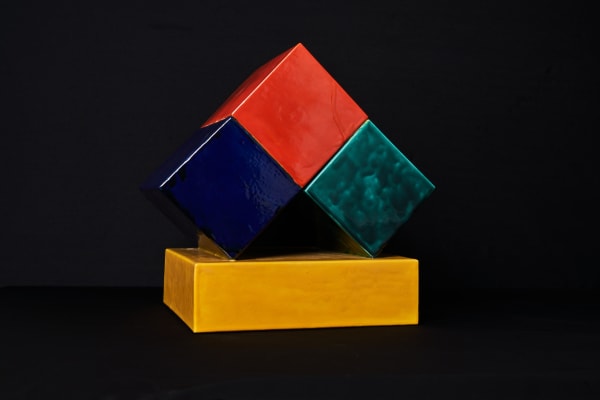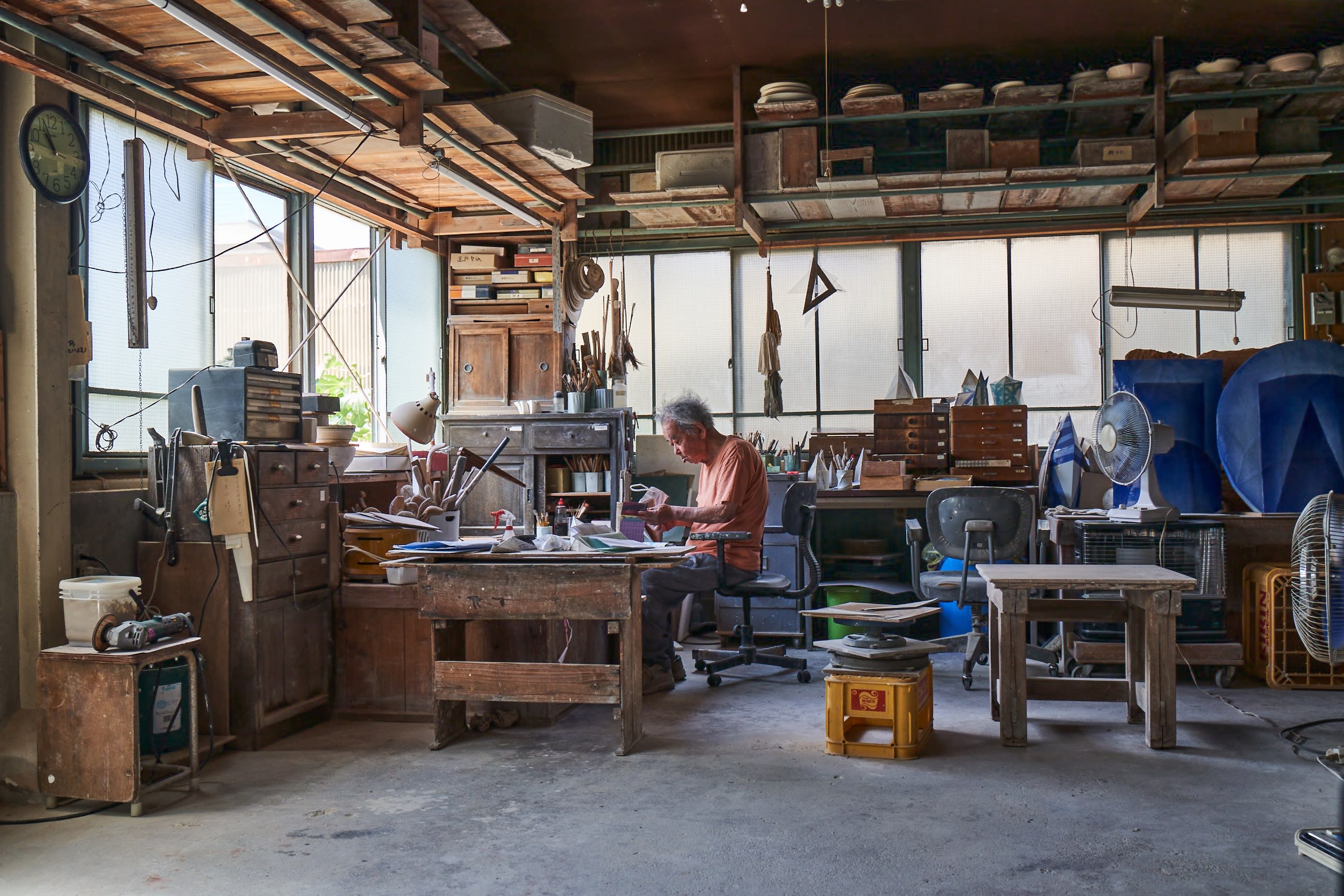-
The Miyanaga People: An Exhibition of Tōzan III
Shibunkaku is pleased to announce “The Miyanaga People: An Exhibition of Tōzan III.”
This exhibition delves into the artistic journey of the third-generation ceramic master, Miyanaga Rikichi, also known as Tōzan III, who celebrates his 88th birthday this year. Shibunkaku will feature a diverse selection of his works, including his latest creations, which exhibit a distinctive blend of geometry and conceptualism that gained prominence in the 1980s. We will also highlight works from the 1970s during his time as active member of Sōdeisha, the avant-garde ceramic group, (“Crawling Through Mud Association”), and works made after his time in the United States. These pieces trace the artist’s creative process through his own selections, including works from the 1960s, which garnered international commendation at the “Trends in Contemporary Art” exhibition at the National Museum of Modern Art, Kyoto, and are still highly acclaimed both domestically and internationally.
This retrospective exhibition, meticulously curated by the Miyanaga family, offers an insightful journey tracing the trajectory of their artistic creations. It not only centers around the works of the Tōzan III, but also extends to the contributions of the previous masters, Tōzan I, and Tōzan II, as well as the next generation, Miyanaga Rikichi’s eldest son and second daughter, Kotaro and Aiko respectively.
We hope visitors will have the opportunity to be immersed in the history and future of the Miyanaga ceramic lineage of Kyoto and look forward to welcoming you to this historic event. -
Highlight
-
 宮永理吉(三代東山)Miyanaga Rikichi (Tōzan III), Mask of three cubes, 1978View more details
宮永理吉(三代東山)Miyanaga Rikichi (Tōzan III), Mask of three cubes, 1978View more details -
 宮永理吉(三代東山)Miyanaga Rikichi (Tōzan III), Mask, 1984View more details
宮永理吉(三代東山)Miyanaga Rikichi (Tōzan III), Mask, 1984View more details -
 初代宮永東山 Miyanaga Tōzan I, Pulling a boat down the Takase River on ceramic tileView more details
初代宮永東山 Miyanaga Tōzan I, Pulling a boat down the Takase River on ceramic tileView more details -
 二代宮永東山 Miyanaga Tōzan II, Flower-shaped incense burner with colored glazedView more details
二代宮永東山 Miyanaga Tōzan II, Flower-shaped incense burner with colored glazedView more details
-
-
Miyanaga Rikichi is here.
Koike Kazuko, Creative DirectorIn this corner of the Tōzan Kiln, you will find Miyanaga Rikichi. He is always present, hunched over in his familiar posture and petite figure appearing even more endearing during the creative process. His steadfastness, unchanged throughout the years, is truly remarkable.
I have been following Miyanaga Rikichi’s work since the mid-1970s and had the privilege of including his creations in an exhibition in Moscow in 1984. He displayed a set of shadow-blue vessels to Russian audiences during the USSR era, not as objets d’art, but as objects of everyday beauty. Our message, as representatives of Japanese art museums, namely the Sezon Museum of Modern Art, was to advocate for a society cherishing the values everyday life. The core of this endeavor, to convey this message to citizens under the former communist regime, was rooted in Miyanaga Rikichi’s own dedication to leading a mindful and deliberate life.
While Miyanaga Rikichi’s sculptural works include exquisite pieces in a delicate blue ceramic, for this particular exhibition, on a complete set of vessels. As we examine daily life, questions about society and the environment inevitably arise. The thematic focus of the exhibition, ‘Japanese Design: Tradition and Modernity’ lies within the realms of clothing, food, and shelter, showcasing the kind of creations emerging in contemporary Japan.
At that time, his daughter, Aiko, was still in primary school. Eventually, she embarked on a path as an artist, and during her overseas studies in Edinburgh, a concept for her first exhibition upon returning to Japan began to take shape through our conversations during her visits to my London home. Alongside her experiences abroad, Aiko decided to reexamine her roots, returning not just to another exhibition space, but instead to the Tōzan Kiln, her family ‘creative space.’ Aiko, having trained at a public ceramics test facility, possessed in-depth knowledge of the intricacies of ceramics. Her diverse experiences equipped her with a somewhat alien sensibility, so to speak, allowing her to explore a new artistic realm.
Aiko’s primary theme is sound, with ‘insertion’ as the focal material – a focus on the act of listening among the five human senses. More than a decade later, and Aiko has now delved into a realm that could be described as a sixth sense, consistently unveiling new works with a conceptual focus.
Through Miyanaga Kotaro’s work, I was introduced to the drama of large installations. It was when a construction made of earth was erected on the rooftop of a food supply building, adjacent to the Sumida River in Tokyo. The building was slated for demolition, and this installation was part of the closing commemorative, ‘Ray of Hope,’ exhibition, curated by Takashi Shinkawa.
Kotaro has expanded his horizon as an artist, participating in projects with Cao Guo-Qiang, among others. As the eldest son inheriting the legacy of Miyanaga Rikichi and the Tozan Kiln, he likely has faced significant expectations and pressure from those around him. However, his response has been to explore and create his unique artistic world, and in doing so, he has quietly acquired persuasive power, with which to answer these questions.
As if to have also supported Aiko as she travels the world, the foundation that has buoyed Miyanaga Rikichi and his unique existence lies in the quality of an artist who inherently possesses an inherent strength of belief in a natural momentum and life force, such as sustainability. With Miyanaga Rikichi’s presence, and the contributions of these three artists, a strong foundation has been laid, supporting each of their distinctive identities. This foundation seems to be rooted in inherent artistic qualities, such as reliance and a belief in the natural force of vitality.
Miyanaga Rikichi is here, as are three remarkable artists.
-
Sodeisha and Avant-garde Ceramics
An interview with Miyanaga Rikichi (Miyanaga Tōzan III), 2020.Sodeisha and Avant-garde Ceramics
An interview with Miyanaga Rikichi (Miyanaga Tōzan III) -
Written by Miyanaga Aiko
-
-
-
The Miyanaga People: An Exhibition of Tōzan III
Past viewing_room











